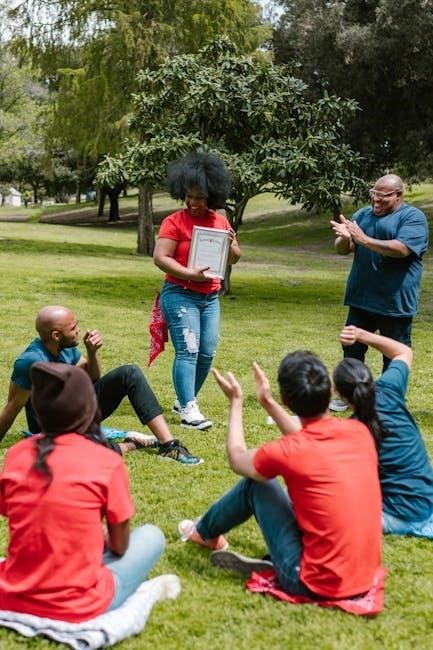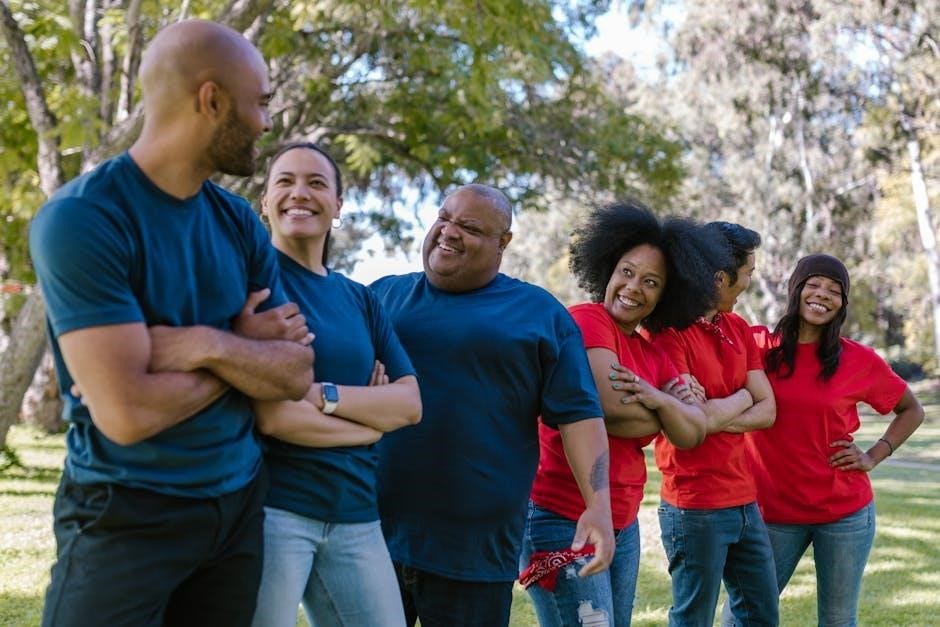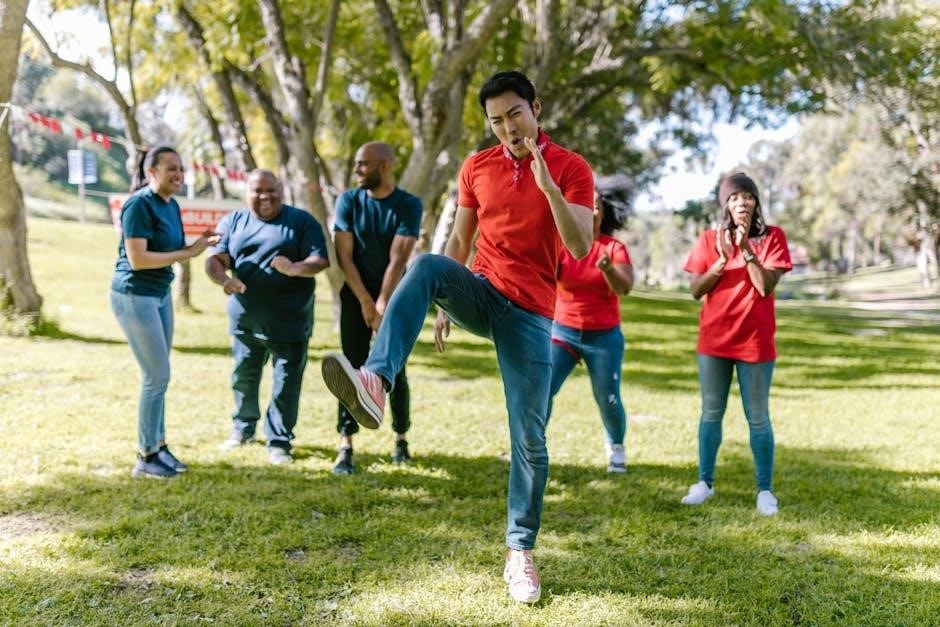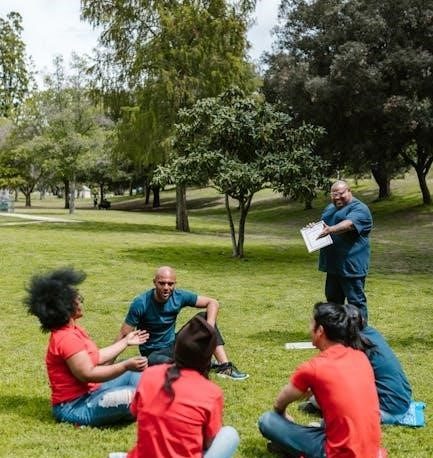Leadership training activities play a crucial role in developing key qualities and styles, offering practical exercises to enhance communication, decision-making, and emotional intelligence, benefiting both individuals and organizations.
1.1 Overview of Leadership Training
Leadership training is a structured process aimed at developing essential skills and qualities in individuals to guide and inspire teams effectively. It focuses on enhancing communication, decision-making, and emotional intelligence, while exploring various leadership styles such as transactional, transformational, and bureaucratic approaches. Training often includes practical exercises, case studies, and role-playing to foster real-world application. By mastering key roles like the architect, bridger, and catalyst, leaders can drive innovation and achieve organizational goals. Effective training empowers individuals to adapt to challenges, build trust, and create a positive work culture, ultimately benefiting both personal and professional growth.

1.2 Importance of Leadership Development
Leadership development is crucial for empowering individuals to inspire and motivate teams, fostering a culture of collaboration and innovation. It enhances empathy, trust, and employee well-being, while addressing the need for adaptable, visionary leaders. By cultivating key qualities, organizations can unlock employee potential, drive growth, and maintain a competitive edge. Effective leadership development also ensures sustainability by identifying and nurturing high-potential employees. Ultimately, it creates a ripple effect, benefiting both individuals and organizations by promoting a culture of continuous learning and improvement.

Key Leadership Qualities to Develop
Effective leadership requires developing essential qualities such as communication, decision-making, emotional intelligence, and visionary thinking to inspire, motivate, and guide teams toward achieving organizational goals successfully.
2.1 Communication Skills
Communication skills are foundational to effective leadership, enabling clear expression of ideas, active listening, and precise articulation of vision. Strong verbal and non-verbal techniques ensure clarity and alignment within teams. According to Harvard Business School experts, mastering communication fosters collaboration, resolves conflicts, and enhances problem-solving. Leaders who communicate effectively build trust, encourage feedback, and create an environment where employees feel heard and valued. This skill is critical for inspiring motivation, driving innovation, and achieving organizational success.
2.2 Decision-Making and Problem-Solving
Effective decision-making and problem-solving are critical leadership skills, enabling leaders to navigate challenges and drive organizational success. According to experts like Linda Hill, these abilities involve critical thinking, strategic planning, and the capacity to weigh risks and opportunities. Leaders must balance data-driven approaches with intuition, fostering a culture of innovation and adaptability. Problem-solving also requires collaboration, empowering teams to contribute ideas and solutions. Strong decision-makers inspire confidence, while their problem-solving skills ensure resilience in dynamic environments. These competencies are essential for transforming obstacles into opportunities and achieving long-term goals.
2.3 Emotional Intelligence
Emotional intelligence (EI) is a vital leadership skill, enabling leaders to understand and manage their emotions and those of others. It fosters empathy, humility, and strong interpersonal connections. According to experts, leaders with high EI can navigate complex social dynamics, build trust, and enhance teamwork. EI also involves self-awareness, self-regulation, and social skills, which are essential for effective communication and conflict resolution. By cultivating EI, leaders can create inclusive environments, improve decision-making, and drive employee well-being. Organizations that prioritize EI development often see increased collaboration, innovation, and overall performance, making it a cornerstone of successful leadership training programs.
2.4 Visionary Thinking
Visionary thinking is a cornerstone of effective leadership, enabling leaders to inspire and guide teams toward a shared future. It involves crafting a compelling vision, aligning goals, and driving innovation. Leaders with strong visionary skills can anticipate trends, identify opportunities, and prepare organizations for long-term success. Visionary thinking fosters a culture of experimentation and resilience, encouraging teams to embrace change. Through activities like strategic planning exercises and scenario analysis, leaders can refine their ability to think critically and creatively. This skill is essential for architects and catalysts, ensuring organizations remain adaptable and forward-thinking in a dynamic world.

Leadership Styles and Their Impact
Leadership styles, such as transactional, transformational, bureaucratic, and laissez-faire, significantly influence organizational culture, employee motivation, and team performance, shaping the overall success of leadership training initiatives.
3.1 Transactional Leadership
Transactional leadership focuses on clear exchanges between leaders and followers, often using rewards or punishments to motivate. It relies on established hierarchies and emphasizes compliance with rules.
This style is effective in structured environments where tasks are routine. However, it can limit creativity and long-term commitment, as it prioritizes short-term goals over personal growth. Leaders using this approach must balance authority with empathy to maintain engagement. While it ensures accountability, it may not foster innovation, making it less suitable for dynamic or creative industries.
3.2 Transformational Leadership
Transformational leadership inspires and motivates followers by creating a shared vision and empowering individuals. It focuses on fostering creativity, innovation, and personal growth, encouraging employees to think beyond their immediate tasks. Leaders using this style build trust and emotional connections, driving commitment to organizational goals. This approach is ideal for driving change and innovation, as it encourages collaboration and ownership. However, it requires leaders to be adaptable and genuinely invested in their team’s success, making it less effective in rigid or bureaucratic environments. It contrasts sharply with transactional leadership, emphasizing inspiration over authority.
3.3 Bureaucratic Leadership
Bureaucratic leadership emphasizes strict adherence to rules, hierarchy, and established processes. It relies on formal authority and clear procedures to maintain consistency and accountability. This style is effective in stable environments where predictability is crucial, such as government or large organizations. However, it can stifle innovation and adaptability, as decisions must follow predefined protocols. Leaders using this approach focus on maintaining order and efficiency but may struggle with fostering creativity or responding to rapid changes. It contrasts with more flexible styles, making it less suitable for dynamic industries requiring quick decision-making and innovation.
3.4 Laissez-Faire Leadership
Laissez-faire leadership is a hands-off approach where leaders delegate most decision-making authority to their team members. This style emphasizes trust in employees’ abilities and encourages autonomy, creativity, and self-motivation. It is effective in environments with skilled, self-reliant teams that require minimal oversight. However, it can lead to disorganization and a lack of direction if team members are not disciplined or experienced. Leaders using this approach focus on providing resources and support while allowing employees to take initiative, making it suitable for innovative or creative projects where flexibility is key.
The Role of Empathy and Humility in Leadership
Empathy and humility are cornerstone traits for effective leaders, fostering trust, collaboration, and a supportive work environment. These qualities enable leaders to connect deeply with their teams.
4.1 Fostering Teamwork
Empathy and humility play a vital role in fostering teamwork by creating an inclusive and supportive environment. Leaders who practice empathy understand team members’ perspectives, enhancing collaboration and trust. Humility encourages leaders to value diverse ideas, promoting a culture of equality and shared responsibility. These traits help leaders address conflicts effectively and celebrate collective successes, strengthening team cohesion. Through active listening and shared decision-making, empathetic and humble leaders empower team members to contribute fully, leading to higher engagement and productivity. Such leadership fosters a sense of belonging, which is essential for achieving common goals and driving organizational success.
4.2 Building Trust

Building trust is a cornerstone of effective leadership, fostering a culture of reliability and collaboration. Leaders who demonstrate transparency, consistency, and accountability cultivate trust within their teams. By maintaining open communication and honoring commitments, leaders establish credibility. Trust also grows when leaders show empathy, actively listen, and support team members’ growth. A trusting environment encourages employees to take ownership of their work and collaborate freely. This, in turn, enhances innovation, commitment, and overall organizational performance. Trust-building activities, such as team discussions and feedback sessions, are essential for strengthening these bonds and creating a resilient, high-performing team.
4.3 Enhancing Employee Well-Being
Empathy and humility in leadership play a crucial role in enhancing employee well-being. Leaders who prioritize their team’s mental and emotional health create a supportive work environment. This fosters resilience, job satisfaction, and higher engagement. By acknowledging stress and offering resources, leaders demonstrate care for their employees’ holistic well-being. Activities such as wellness workshops, flexible work arrangements, and mental health discussions can be integrated into leadership training. Recognizing and addressing burnout while promoting work-life balance further strengthens employees’ overall well-being, leading to a more motivated and productive workforce.

The Architect, Bridger, and Catalyst Roles
The Architect designs the vision, the Bridger connects people and resources, and the Catalyst drives innovation. These roles ensure strategic alignment, collaboration, and growth. Architects create roadmaps, Bridgers foster connections, and Catalysts initiate change, collectively propelling organizational success.
5.1 Architect: Designing the Vision
The Architect role focuses on designing and communicating a clear vision to guide the organization. This involves defining long-term goals, aligning teams, and ensuring everyone understands the strategic direction. Architects use tools like workshops, scenario planning, and SWOT analysis to create actionable plans. They also foster collaboration by breaking down silos and encouraging cross-functional teamwork. Effective Architects inspire confidence by linking daily tasks to the broader vision, ensuring alignment and purpose in every initiative.
5.2 Bridger: Connecting People and Resources
The Bridger role excels at fostering connections between individuals, teams, and resources to enhance collaboration and productivity. This involves identifying gaps, facilitating communication, and ensuring seamless workflow. Bridgers cultivate trust by actively listening and addressing team needs, often using techniques like network mapping and cross-functional meetings. They also allocate resources effectively to support projects, aligning them with strategic goals. By breaking down barriers, Bridgers create an environment where diverse perspectives thrive, leading to innovative solutions and stronger organizational cohesion.
5.3 Catalyst: Driving Innovation
The Catalyst role is centered around igniting change and fostering a culture of innovation. Leaders in this role encourage creative thinking, challenge the status quo, and inspire others to explore new ideas. They facilitate brainstorming sessions, promote experimentation, and support calculated risk-taking. Catalysts thrive in dynamic environments, leveraging diverse perspectives to drive breakthrough solutions. By embracing failure as a learning opportunity, they cultivate resilience and a growth mindset within teams. This role is essential for organizations aiming to stay competitive and adapt to evolving challenges, ensuring continuous improvement and progress. Their impact is measurable through tangible advancements and a culture of forward-thinking.

Developing High-Potential Employees

Identifying and nurturing future leaders is crucial for organizational success. High-potential employees are cultivated through tailored development plans, mentorship, and targeted training to enhance their leadership capabilities and readiness.
6.1 Identifying Future Leaders
Identifying future leaders involves recognizing individuals with exceptional potential, strong work ethic, and a natural ability to inspire others. Organizations often use performance evaluations, psychometric assessments, and feedback from peers and managers to pinpoint high-potential employees. These individuals typically demonstrate initiative, resilience, and a willingness to take on challenges. Leadership training activities, such as simulations and group exercises, can also reveal candidates with innate leadership qualities. Aligning identification processes with organizational goals ensures that future leaders can drive long-term success and adapt to evolving challenges. Early recognition allows for tailored development, enhancing their readiness for advanced roles. This step is pivotal for sustaining leadership pipelines.
6.2 Creating Development Plans
Creating development plans is essential for nurturing future leaders. These plans are tailored to address individual strengths and weaknesses, aligning with organizational objectives. They include specific, measurable goals; relevant training activities; mentorship opportunities; and feedback mechanisms. Regular assessments ensure progress and allow for necessary adjustments. Effective development plans not only enhance leadership capabilities but also prepare individuals for advanced roles, fostering a culture of continuous improvement and contributing to the organization’s long-term success.

The Importance of Continuous Learning
Continuous learning is vital for leaders to adapt to evolving challenges, stay updated with industry trends, and enhance problem-solving skills, ensuring sustainable growth and innovation.
7.1 Recommended Leadership Books
Enhancing leadership skills requires continuous learning, and books are a valuable resource. Notable titles include “The Five Dysfunctions of a Team” by Patrick Lencioni, which explores team dynamics, and “Drive” by Daniel Pink, focusing on motivation. “Start with Why” by Simon Sinek emphasizes purpose-driven leadership. “The Lean Startup” by Eric Ries offers insights into entrepreneurial leadership. “Leaders Eat Last” by Simon Sinek highlights putting the team first. “The 7 Habits of Highly Effective People” by Stephen Covey provides timeless principles. Lastly, “Dare to Lead” by Brené Brown explores modern leadership. These books are essential for any leadership development journey.
Practical Leadership Training Activities
Practical leadership training activities enhance skills through real-world applications. Team-building exercises foster collaboration, while role-playing scenarios simulate decision-making challenges. Case studies encourage problem-solving and strategic thinking.
8.1 Team-Building Exercises
Team-building exercises are essential for fostering collaboration and trust among team members. Activities like escape rooms, scavenger hunts, or outdoor challenges encourage problem-solving and communication. These exercises help leaders develop interpersonal skills, such as active listening and conflict resolution, while promoting a shared sense of purpose. By working together, participants build stronger relationships and learn to rely on each other’s strengths. Team-building also enhances accountability and creativity, preparing leaders to handle real-world challenges effectively. These exercises are often included in leadership training programs to create a cohesive and motivated team environment.
8.2 Role-Playing Scenarios
Role-playing scenarios are interactive exercises where participants act out real-life leadership challenges, such as managing conflicts or delivering feedback. These activities allow leaders to practice decision-making, communication, and emotional intelligence in a controlled environment. Scenarios are tailored to address common workplace situations, enabling leaders to refine their responses and adapt to diverse perspectives. Feedback from facilitators and peers helps participants identify strengths and areas for improvement. Role-playing fosters confidence and prepares leaders to handle complex situations effectively, making it a valuable tool in leadership development programs.
8.3 Case Study Analysis
Case study analysis involves examining real-world leadership scenarios to understand challenges, decisions, and outcomes. Participants review detailed narratives of organizational situations, identifying key issues and potential solutions. This method encourages critical thinking, problem-solving, and collaboration. By analyzing successes and failures, leaders gain practical insights into effective strategies. Case studies often include group discussions, fostering diverse perspectives and shared learning. This approach helps leaders apply theoretical concepts to real-world problems, enhancing their ability to navigate complex situations and make informed decisions in their own roles.

Best Practices for Effective Leadership Training
Effective leadership training requires aligning programs with organizational goals, incorporating feedback, fostering continuous learning, and using practical exercises to enhance skill development and real-world application.
9.1 Aligning Training with Organizational Goals
Aligning leadership training with organizational goals ensures programs are relevant and impactful. Start by identifying key objectives and involving stakeholders to understand specific needs. Define clear outcomes tied to the organization’s mission and vision. Tailor content to address gaps and prioritize skills that drive success. Use real-world scenarios and case studies that mirror organizational challenges. Regularly monitor progress and adjust training strategies to stay aligned with evolving goals. This approach ensures leaders develop skills that directly contribute to achieving organizational objectives, fostering a culture of purposeful development and continuous improvement.
9.2 Incorporating Feedback and Assessment
Incorporating feedback and assessment into leadership training ensures measurable growth and accountability. Use 360-degree evaluations to gather insights from peers, subordinates, and superiors. Regularly conduct skill assessments to identify strengths and areas for improvement. Implement feedback loops where leaders receive constructive criticism and actionable steps. Use assessment tools like quizzes, simulations, and presentations to evaluate progress. Continuous feedback helps refine training programs, ensuring they address real-world challenges. This iterative process fosters a culture of learning and improvement, enabling leaders to align their development with organizational expectations and deliver impactful results.
